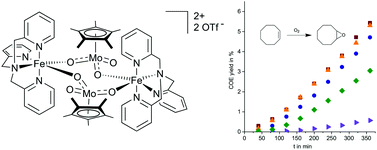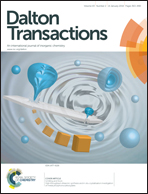Abstract
The reaction between [(TPA)Fe(MeCN)2](OTf)2 and [nBu4N](Cp*MoO3) yields the novel tetranuclear complex [(TPA)Fe(μ-Cp*MoO3)]2(OTf)2, 1, with a rectangular [Mo–O–Fe–O–]2 core containing high-spin iron(II) centres. 1 proved to be an efficient initiator/(pre)catalyst for the autoxidation of cis-cyclooctene with O2 to give cyclooctene epoxide. To test, which features of 1 are essential in this regard, analogues with zinc(II) and cobalt(II) central atoms, namely [(TPA)Zn(Cp*MoO3)](OTf), 3, and [(TPA)Co(Cp*MoO3)](OTf), 4, were prepared, which proved to be inactive. The precursor compounds of 1, [(TPA)Fe(MeCN)2](OTf)2 and [nBu4N](Cp*MoO3) as well as Cp2*Mo2O5, were found to be inactive, too. Reactivity studies in the absence of cyclooctene revealed that 1 reacts both with O2 and PhIO via loss of the Cp* ligands to give the triflate salt 2 of the known cation [((TPA)Fe)2(μ-O)(μ-MoO4)]2+. The cobalt analogue 4 reacts with O2 in a different way yielding [((TPA)Co)2(μ-Mo2O8)](OTf)2, 5, featuring a Mo2O84− structural unit which is novel in coordination chemistry. The compound [(TPA)Fe(μ-MoO4)]2, 6, being related to 1, but lacking Cp* ligands failed to trigger autoxidation of cyclooctene. However, initiation of autoxidation by Cp* radicals was excluded via experiments including thermal dissociation of Cp2*.


 Please wait while we load your content...
Please wait while we load your content...